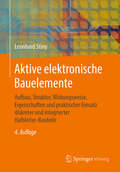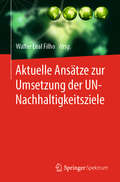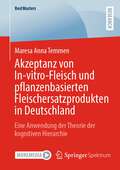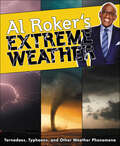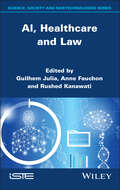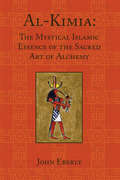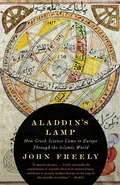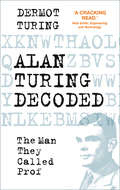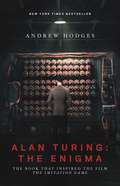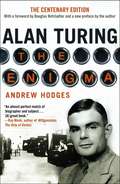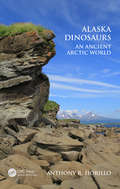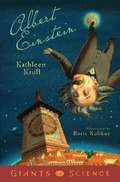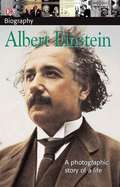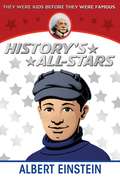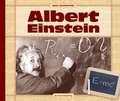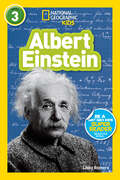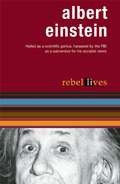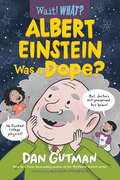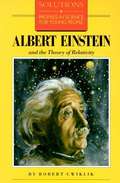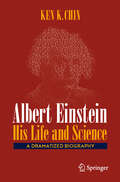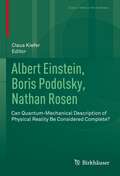- Table View
- List View
Aktive elektronische Bauelemente: Aufbau, Struktur, Wirkungsweise, Eigenschaften Und Praktischer Einsatz Diskreter Und Integrierter Halbleiter-bauteile
by Leonhard StinyDas Werk bietet ein umfangreiches Wissen über diskrete und integrierte Bauelemente der Halbleitertechnik. Beim Entwurf elektronischer Schaltungen sind gründliche Kenntnisse über eingesetzte Bauelemente erforderlich, um sowohl technisch als auch wirtschaftlich beste Lösungen zu finden und fehlerfreie Produkte zu realisieren. Als Basis werden die theoretischen und physikalischen Grundlagen der Halbleitertechnik vermittelt. Für alle Halbleiter-Bauelemente werden Aufbau, Wirkungsweise, Kenngrößen, Eigenschaften und Charakteristiken erläutert. Mögliche Anwendungen werden unter Bezug auf die Praxis aufgezeigt. Das Buch kann im Studium, in der Lehre sowie als Nachschlagewerk in der Praxis verwendet werden.
Aktuelle Ansätze zur Umsetzung der UN-Nachhaltigkeitsziele
by Walter Leal FilhoDas Buch befasst sich mit den Themen Nachhaltigkeit und Nachhaltigkeitsziele der UN. Obwohl letztere schon 2015 verabschiedet wurden und die Umsetzung bis 2030 abgeschlossen sein soll, herrscht gegenwärtig noch immer ein Mangel an Initiativen, die die Nachhaltigkeitsziele zum Thema haben. Das Buch stößt eine Diskussion darüber an, wie das Thema Nachhaltigkeit ganzheitlich in der Lehre, Forschung, Wirtschaft und Gesellschaft eingeführt und bearbeitet werden kann. Eine Vielzahl unterschiedlicher Disziplinen, von den Sozial- und Wirtschaftswissenschaften über Mode- und Kunst- sowie Umweltwissenschaften bis hin zu den Sprach- und Medienwissenschaften tragen zu dem Werk bei. Im Fokus des Buchs stehen die Mittel und Wege, mit denen das Engagement der Hochschulen und Nichtregierungsorganisationen in den globalen Bemühungen zur Umsetzung der Nachhaltigkeitsziele zusammengeführt wird. Der Band vereinigt viele Erfahrungen und Fallstudien, die zur Weiterentwicklung des Themas „Umsetzung der SDGs“ beitragen.
Akzeptanz von In-vitro-Fleisch und pflanzenbasierten Fleischersatzprodukten in Deutschland: Eine Anwendung der Theorie der kognitiven Hierarchie (BestMasters)
by Maresa Anna TemmenMaresa Anna Temmen untersucht auf Grundlage der Theorie der kognitiven Hierarchie die Konsumbereitschaft für In-vitro-Fleisch und pflanzenbasierte Fleischersatzprodukte in Deutschland. Hierzu werden unter anderem ernährungspsychologische Einflussfaktoren genutzt, die sich auf moralische und ideologische Einstellungen zum Fleischkonsum beziehen. Die Ergebnisse der quantitativen Online-Fragebogenstudie zeigen, dass die Konsumbereitschaft für In-vitro-Fleisch und pflanzenbasierte Fleischersatzprodukte in der deutschen Bevölkerung relativ hoch ist und stützen die Theorie der kognitiven Hierarchie: Entsprechend können eine universalistisch geprägte Wertestruktur, eine geringe soziale Dominanzorientierung, eine geringe Ausprägung von Speziesismus und karnistischer Dominanz sowie eine geringe Unterstützung von Rechtfertigungsstrategien für den Konsum von Fleisch Gründe für eine hohe Konsumbereitschaft von In-vitro-Fleisch und pflanzenbasierten Fleischalternativen sein. Die Studie zeigt, dass tiefliegende Persönlichkeitsvariablen wie Werte und Wertorientierungen einen Einfluss auf spezifischere Einstellungen nehmen, die wiederum einen Einfluss auf die Konsumbereitschaft von Fleischalternativen haben.
Al Roker's Extreme Weather: Tornadoes, Typhoons, and Other Weather Phenomena
by Al RokerNew York Times bestselling author, award-winning meteorologist, and TodayShow co-anchor Al Roker explores extreme weather phenomena in his first book for kids. This middle grade book is an excellent choice for tween readers in grades 5 to 6, especially during homeschooling. It’s a fun way to keep your child entertained and engaged while not in the classroom. Dive deep into a world of fascinating weather with everyone’s favorite meteorologist, Al Roker!With this mesmerizing book that covers a wide range of topics, readers will learn about the conditions that generate unique weather occurrences like red sprites, thundersnow, and fogsicles.Surprising facts, colorful spreads, and captivating pictures will hook children and adults alike as they uncover the mysteries of extreme weather—some they never even knew existed!
Al, Healthcare and Law (ISTE Invoiced)
by Anne Fauchon Rushed Kanawati Guilhem JuliaIn a fully digitized world and hyper-connected society, artificial intelligence (AI) is developing more and more each day. In the aftermath of the Covid-19 pandemic, it seems appropriate to examine the real or imagined progress of AI in terms of human health. Like artificial intelligence, health is a field that involves a wide range of research disciplines. In order to better define and understand these social and technical developments, Al, Healthcare and Law brings together the thoughts and analyses of doctors, lawyers, economists and computer scientists. Through a wide range of original overviews of the issues involved, the book addresses questions such as the development of telemedicine, the use of medical data, the increased human perspective or medical ethics, and takes a multi-disciplinary and accessible approach to questioning the relationship between humans and computers, between the intimate and the machine.
Al-Kimia: The Mystical Islamic Essence of the Sacred Art of Alchemy
by John EberlyAl-Kimia - The Mystical Islamic Essence of the Sacred Art of Alchemy by John Eberly presents a condensed history of Alchemy told through concise biographies of early Sufi Masters, Chapters examine occult areas of alchemical and spiritual interest such as jafr, an exegetical Qur'anic science akin to Hebrew Qabala; the Qiyamat or 'Great Resurrection', of the heretical Ismaili sect; the contrary path of the saintly Malamatiyya or 'blameworthy ones'; Hermetic color theory, and 'hidden' art history. A glossary of transliterated terms is appended that will greatly help the beginner as well as the advanced student of these subjects. Al-Kimia is a sound scholarly treatment of the Islamic contribution to the art of alchemy, a rich compendium of Sufi, Shi'ite, and Hermetic lore, and a string of spiritual meditations so concentrated and poetic as to be 'operative', God-willing, on the subtle material of the reader's psyche. It even ends with a recipe fro an actual beginner's alchemical operation. In density and lucidity, a real 'gem'. Charles Upton, author of The System of Antichrist The appearance of John Eberly's consummate Al-Kimia: The Mystical Islamic Essence of the Sacred Art of Alchemy is indeed cause for celebration. Readers already devoted to alchemical research are rewarded by Eberly's lucid presentation of the great adepts and their relationship to the various lineages and schools. For those less familiar with the Sacred Art, in this time of ever heightening crisis, Eberly's text provides an urgently needed opportunity to appreciate the rich and diverse history and culture of the Islamic world. Jay Bremyer, author of The Dance of Created Lights: A Sufi Tale
Alabama Grade 7 Prentice Hall Science Explorer
by Cyr Padilla MiaoulisLead author Michael Padilla once again sets the standard for engaging, hands-on science exploration. Correlates to Alabama state standards.
Aladdin's Lamp
by John FreelyAladdin’s Lamp is the fascinating story of how ancient Greek philosophy and science began in the sixth century B.C. and, during the next millennium, spread across the Greco-Roman world, producing the remarkable discoveries and theories of Thales, Pythagoras, Hippocrates, Plato, Aristotle, Euclid, Archimedes, Galen, Ptolemy, and many others. John Freely explains how, as the Dark Ages shrouded Europe, scholars in medieval Baghdad translated the works of these Greek thinkers into Arabic, spreading their ideas throughout the Islamic world from Central Asia to Spain, with many Muslim scientists, most notably Avicenna, Alhazen, and Averroës, adding their own interpretations to the philosophy and science they had inherited. Freely goes on to show how, beginning in the twelfth century, these texts by Islamic scholars were then translated from Arabic into Latin, sparking the emergence of modern science at the dawn of the Renaissance, which climaxed in the Scientific Revolution of the seventeenth century.
Alan M. Turing
by Sara TuringTuring's reputation has grown, as his contributions to logic, mathematics, computing, and artificial intelligence have become better appreciated. This republication of his mother's biography is enriched by a never-before-published memoir by Alan's older brother.
Alan Turing Decoded: The Man They Called Prof
by Dermot Turing‘A cracking read. ’Nick Smith, Engineering and TechnologyAlan Turing was an extraordinary man who crammed into his 42 years the careers of mathematician, codebreaker, computer scientist and biologist. He is widely regarded as a war hero grossly mistreated by his unappreciative country, and it has become hard to disentangle the real man from the story. It is easy to cast him as a misfit, the stereotypical professor. But actually Alan Turing was never a professor, and his nickname ‘Prof’ was given by his codebreaking friends at Bletchley Park. Now Dermot Turing has taken a fresh look at the influences on his uncle’s life and creativity, and the creation of a legend. He discloses the real character behind the cipher-text, answering questions that help the man emerge from his legacy: how did Alan’s childhood experiences influence him? How did his creative ideas evolve? Was he really a solitary genius? What was his wartime work after 1942, and what of the Enigma story? What is the truth about the conviction for gross indecency, and did he commit suicide? In Alan Turing Decoded, Dermot’s vibrant and entertaining approach to the life and work of a true genius makes this a fascinating and authoritative read.
Alan Turing: The Book That Inspired the Film The Imitation Game - Updated Edition
by Andrew HodgesA NEW YORK TIMES BESTSELLERThe official book behind the Academy Award-winning film The Imitation Game, starring Benedict Cumberbatch and Keira KnightleyIt is only a slight exaggeration to say that the British mathematician Alan Turing (1912–1954) saved the Allies from the Nazis, invented the computer and artificial intelligence, and anticipated gay liberation by decades—all before his suicide at age forty-one. This New York Times bestselling biography of the founder of computer science, with a new preface by the author that addresses Turing&’s royal pardon in 2013, is the definitive account of an extraordinary mind and life.Capturing both the inner and outer drama of Turing&’s life, Andrew Hodges tells how Turing&’s revolutionary idea of 1936—the concept of a universal machine—laid the foundation for the modern computer and how Turing brought the idea to practical realization in 1945 with his electronic design. The book also tells how this work was directly related to Turing&’s leading role in breaking the German Enigma ciphers during World War II, a scientific triumph that was critical to Allied victory in the Atlantic. At the same time, this is the tragic account of a man who, despite his wartime service, was eventually arrested, stripped of his security clearance, and forced to undergo a humiliating treatment program—all for trying to live honestly in a society that defined homosexuality as a crime.The inspiration for a major motion picture starring Benedict Cumberbatch and Keira Knightley, Alan Turing: The Enigma is a gripping story of mathematics, computers, cryptography, and homosexual persecution.
Alan Turing: The Enigma (The Centenary Edition)
by Andrew HodgesIt is only a slight exaggeration to say that the British mathematician Alan Turing (1912-1954) saved the Allies from the Nazis, invented the computer and artificial intelligence, and anticipated gay liberation by decades--all before his suicide at age forty-one. This classic biography of the founder of computer science, reissued on the centenary of his birth with a substantial new preface by the author, is the definitive account of an extraordinary mind and life. A gripping story of mathematics, computers, cryptography, and homosexual persecution, Andrew Hodges's acclaimed book captures both the inner and outer drama of Turing's life. Hodges tells how Turing's revolutionary idea of 1936--the concept of a universal machine--laid the foundation for the modern computer and how Turing brought the idea to practical realization in 1945 with his electronic design. The book also tells how this work was directly related to Turing's leading role in breaking the German Enigma ciphers during World War II, a scientific triumph that was critical to Allied victory in the Atlantic. At the same time, this is the tragic story of a man who, despite his wartime service, was eventually arrested, stripped of his security clearance, and forced to undergo a humiliating treatment program--all for trying to live honestly in a society that defined homosexuality as a crime.
Alaska Dinosaurs: An Ancient Arctic World
by Anthony R. FiorilloAnthony Fiorillo has been exploring the Arctic since 1998. For him, like many others, the Arctic holds the romance of uncharted territory, extreme conditions, and the inevitable epic challenges that arise. For Fiorillo, however, the Arctic also holds the secrets of the history of life on Earth, and its fossils bring him back field season after field season in pursuit of improving human understanding of ancient history. His studies of the rocks and fossils of the Arctic shed light on a world that once was, and provide insight into what might be.
Alaska's Animals, You And I
by Shannon CartwrightAlaska's Animals shows how various animals are different, comparing things like noses, feet, tails and dwellings with colorful, detailed and clever close-up compositions. All illustrations are accompanied by Shannon Cartwright's lyrical verses that roll.
Albert Einstein
by Kathleen Krull Boris KulikovAlbert Einstein. His name has become a synonym for genius. His wild case of bedhead and playful sense of humor made him a media superstar?the first, maybe only, scientist-celebrity. He wasn?t much for lab work; in fact he had a tendency to blow up experiments. What he liked to do was think, not in words but in ?thought pictures.? What was the result of all his thinking? Nothing less than the overturning of Newtonian physics. Once again, Kathleen Krull delivers a witty and astute look at one of the true ?Giants of Science? and the turbulent times in which he lived.
Albert Einstein
by Frieda WishinskyDKY's acclaimed DK Biography series tackles two of history's most colorful figures in Harry Houdini and Albert Einstein. Perfect for book reports or summer reading, the DK Biography series brings a new clarity and narrative voice to history's most colorful figures.
Albert Einstein
by Marie Hammontree Robert DoremusBefore Albert Einstein was an internationally renowned genius, he was a kid--learn all about his childhood and what makes him an all-star in American history!Albert Einstein is a household name synonymous with genius around the world. His work unlocked mysteries of the universe and also impacted everyday conveniences like remote controls and televisions. And while most are familiar with Einstein's adult wisdom (and wild hair), do you know what he was like as a child? From his passion for music--he played both the violin and the piano--to his early curiosity for understanding the mysteries of science, in this narrative biography you'll learn all about Albert Einstein's childhood and the influences that shaped the life of a remarkable man.
Albert Einstein (Basic Biographies)
by Susan KesselringA very simple introduction to the life and accomplishments of noted physicist Albert Einstein.
Albert Einstein (Readers Bios)
by Libby RomeroExplore one of the most recognized scientists in the world with this biography of physicist Albert Einstein. Kids will learn about his life, achievements, and the challenges he faced along the way. The level 3 text provides accessible, yet wide-ranging, information for independent readers.
Albert Einstein (Rebel Lives)
by Albert Einstein Tom KeebleEinstein as an absent-minded genius with his head in the clouds is a far cry from the real picture. A man deeply interested in social issues, Einstein felt it was his duty to use his fame and intellect to advance the cause of social justice.
Albert Einstein Was a Dope? (Wait! What? #0)
by Dan GutmanFrom the best-selling author behind My Weird School: a quirky new biography series that casts fresh light on high-interest historic figures. Did you know that Albert Einstein was a high school dropout, and that he failed his physics class when he finally made it to college? Or that when he died, his brain and eyeballs were removed from his body? Ever wondered why his hair looked so wild? Siblings Paige and Turner do—and they’ve collected some of the kookiest and most unusual facts about the world-famous scientist, from his childhood and school days through his time studying relativity and working on the atomic bomb. Narrated by the two spirited siblings and animated by Allison Steinfeld’s upbeat illustrations, Albert Einstein Was a Dope? expertly balances authoritative information with Dan Gutman’s signature zany humor.
Albert Einstein and Relativity for Kids: His Life and Ideas with 21 Activities and Thought Experiments (For Kids series)
by Jerome PohlenBest known for his general theory of relativity and the famous equation linking mass and energy, E = mc², Albert Einstein had a lasting impact on the world of science, the extent of which is illuminated--along with his fascinating life and unique personality--in this lively history. In addition to learning all about Einstein's important contributions to science, from proving the existence and size of atoms and launching the field of quantum mechanics to creating models of the universe that led to the discovery of black holes and the big bang theory, young physicists will participate in activities and thought experiments to bring his theories and ideas to life. Such activities include using dominoes to model a nuclear chain reaction, replicating the expanding universe in a microwave oven, creating blue skies and red sunsets in a soda bottle, and calculating the speed of light using a melted chocolate bar. Suggestions for further study, a time line, and sidebars on the work of other physicists of the day make this an incredibly accessible resource for inquisitive children.
Albert Einstein and the Theory of Relativity
by Robert CwiklikEinstein's astonishing theory of relativity transformed every aspect of physics-from the study of atoms to the study of stars. Relativity is described here in simple, accurate language that young readers can comprehend. From the back cover Written to challenge the imaginations of young readers, ages 12-13, Barron's exciting Solutions Series presents dramatic stories of brilliant scientists and their discoveries that have changed our civilization. The excitement of scientific challenge and the thrill of the solutions found by men and women of science make stories that will inspire and entertain youthful readers. Teachers will also value these volumes for their supplementary aids, including glossaries and topic lists for essays.
Albert Einstein – His Life and Science: A Dramatized Biography
by Ken K. ChinThis book is part biographical account, part novel, and part popular science. The basic facts are historically true, but many episodes have additionally been dramatized with plausible content that brings the personal story to life in the style of a novel or movie script. This genre of a “dramatized biography" of scientists was first created by the author 45 years ago and became a great success selling over half a million copies in China, where it has been in particular demand for teaching. But this is not the whole story: In addition, the book explains, in a serious yet accessible manner, the basics of Einstein’s scientific work, especially its impact on contemporary cosmology, astronomy, and physics. As an experienced teacher of relativity and astronomy for high-school and university students, the author knows how to make profound scientific subjects accessible, and his presentation is as fascinating as a detective story. Readers will learn not only about the historical setting but also about the challenges and frustrations faced by Einstein, about his breakthroughs and triumphs, as well as the far-reaching significance of his theory of relativity, quantum mechanics, and other scientific achievements. The reader will come to understand why, of all the billions of people living in the twentieth century, Albert Einstein was singled out as the “Person of the Century.”
Albert Einstein, Boris Podolsky, Nathan Rosen: Can Quantum-Mechanical Description of Physical Reality Be Considered Complete? (Classic Texts in the Sciences)
by Claus KieferThe work published by Einstein, Podolsky and Rosen (EPR) in 1935 is a classic in modern physics. It discusses, for the first time, the central feature of the quantum theory: entanglement. In general, systems are intertwined with each other in nature; that is, they have only one common, non-divisible state. This fact is responsible for all the oddities commonly associated with quantum theory, including the famous thought experiments with Schrödinger’s cat and Wigner’s friend. The entanglement of quantum mechanics plays a central role in experiments with atoms and photons (Nobel Prize 2012 for Haroche and Wineland) and the planned construction of quantum computers. This book presents EPR’s original work amplified with a detailed commentary, which examines both the historical context and all aspects of entanglement. In particular, it focuses on the interpretation of quantum theory and its consequences for a basic understanding of nature.
